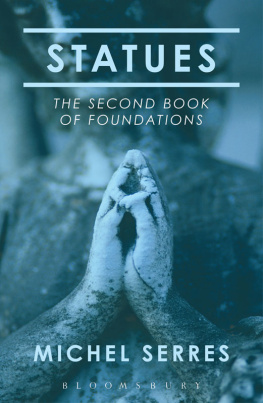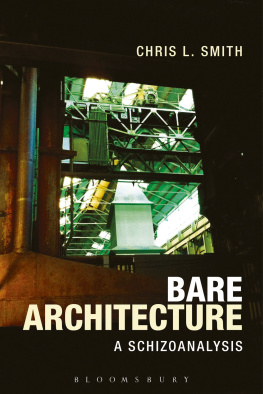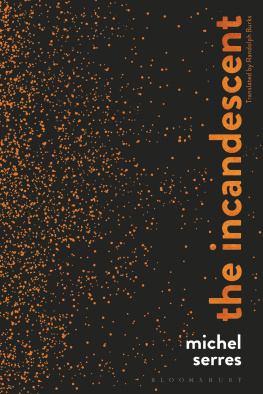STATUES
ALSO AVAILABLE FROM BLOOMSBURY
Rome , Michel Serres (translated by Randolph Burks)
Times of Crisis , Michel Serres (translated by Anne-Marie Feenberg-Dibon)
The Five Senses , Michel Serres (translated by Margaret Sankey and Peter Cowley)
For Christiane Frmont
STATUES
The Second Book of Foundations
Michel Serres
(translated by Rando lph Burks)
STATIONS
We remember having seen on television recently, at the same time as millions of viewers around the world, the rocket Challenger leave its take-off area at 11:39 on January 28, 1986, only to disintegrate 74 seconds later, incinerating the bodies of the seven crew members (including a 37-year-old teacher, a mother of two) who had settled in for the voyage into space. We were horrified. Europeans had, a few years earlier, witnessed in huge numbers the explosion of the Soviet supersonic plane at the Le Bourget air show, near Paris. In the first case more than the second, the television rebroadcast the accident hundreds of times so that most of us would witness it, watch it again and again, and remember it.
Individually, we remember accidents of the same type happening to automobiles, buses or railway cars, and we remember charred bodies among the black and twisted structures, but we view these accidents alone or only in the company of a few witnesses or rescuers. We also remember the captivating power that attracts those nearby around these mass graves: passers-by congregate. Businesses based on the spectacle exploit that attraction; the television transforms the event into a rite and reproduces it in front of gigantic audiences.
We have no difficulty remembering these catastrophes, since the media give us tragedy several times a day, covering the West with a veil of melancholy, without a crack. But who among us remembers Phalaris? During the sixth century before Christ, in Sicily, a tyrant from Agrigentum who bore that name had an enormous hollow bronze bull sculpted or assembled. It was erected in the center of the public square and brought to a cherry red by a fire after being filled with enemies. People came in droves to hear the bellowing of the beast.
On the other side of the sea, in Carthage, said enemies of the Agrigentines sometimes attended the worship of Baal, that multiple and fascinating god that the Jewish and Christian texts condemned under the names of Belphegor and Beelzebub, the god of the dung heap, the lord of the flies. The shoulders of his statue stood above the walls and fortifications; out in the countryside, it could be seen from very far away; to get it out of the temple, the walls had to be pulled down; it was hauled on runners and cylinders, a kind of rail was invented; the crowd was in a great crush before it, held back by trellis-work that only the priests, scholars, or specialists, could get past so as to approach the colossus and look after it; seven tiered compartments opened in the gods body: provisions were placed in one and in the other an ape, etc., only the last one remained open and empty; the celestial spaces, the heavens, the stars, the moon and the constellations were invoked, brought into relation with the multitude by way of that metal shell; it was offered splendid jewels, gold and diamonds first, it was excessively expensive; then a blazing fire was lit under the foundations of the colossus with aloe, laurel, cedar, and an oil flame; and the crowd shouted glory be to space! while the fire roared, filling the place with eddies of smoke that almost made the giant statue disappear in a cloud. The gods arms, worked by chains from behind by means of subtle machinery, then swooped down on an enclosure where children had previously been left, children who were believed to be the first-born of the rich and noble families; one after the other, they were placed in the movable hand that by going back upright like an elevator threw them into the empty compartment prepared for them and by then close to the fusion, while the crowd cried: They are not men but oxen. Oxen, oxen! The victims disappeared like drops of water on a red-hot plate, multiplying the plumes of smoke that spread over the plain and the city in the direction of the stars.
This is pretty much how Flaubert describes the worship of Baal in Carthage under Hamilcar Barca during Hannibals youth in the thirteenth chapter of Salammbo . Do we remember the novel and the sacrifices to Moloch, we contemporaries, scientists or ignoramuses of space?
Assume a dictionary that allows the scene that happened that year at Cape Canaveral and the abominable rite to be translated. A column on the left would be read in one language and on the right in another. Just as much of a crowd, on one side as on the other, forms a great crush at the tragic spectacle and gapes with horror; the Ancients and the Moderns designate the heavens as the aim and target of their aspirations or projects, space and the stars; the undertaking is expensive, for the Carthaginians as for us, the nation almost bankrupts itself over it; both of them divide their group and carefully separate the common man or those watching from the specialists, shut away, specially clothed, designated as priests or technicians of the thing or its representation; here the blast-off, Immobile at first, the statue moves and leaves. But the idol and the rocket are tombs. End of the dictionary in the black box.
The translation of one column of the lexicon into the other meets with many invariants, crowd for crowd, fire for fire, deaths and observers, and terrifies us into the bargain, uneasy about taking up the same gestures today as long ago. But heres what eases our minds: the difference from the idol to the vehicle separates the enterprise from the rite and the accident from the crime. We really go to the places that Antiquity only pretended to in dream; it designated the heavens, we traverse them. Conversely, it perpetrated murder, intentional and real, whereas were undergoing a technical setback. The situations cut across and oppose each other instead of resembling one another. We can, they dreamed; we know, they didnt. The first lie on their part.
The second lie was the appalling lamentation that rose from the audience: no, they are not men, but oxen. The fathers and mothers, seeing the murder of their children, said that they didnt know what they were doing, as though it proved more difficult to say than to do. Listen to the litany, probe its depths. No, no, we dont know, we wont say. A lie or an admission?
No, its not about human sacrifice, but merely an accident. We dont hear that litany today. And yet why rerun those deaths on television so obligingly for everyone to assuage themselves or to eat their fill at their leisure? We dont make any admissions. And what if we too did strange things without saying them?
I feel the shudder of anger experienced at the comparison of the two scenes, a comparison that makes a disturbing light come to us from so far away. This shudder would make us go astray, if it led us to dismiss certain questions. Our intellectual traditions insist that every clarity be made over our mistakes, failings, failures, lies, accidents, even at the risk of making ourselves uncomfortable.
Id prefer to bring intelligence into those two boxes full of men and ignition [ mises feu ], blacker than those we place as black boxes in the vehicles whose reliability we want to assess. In other words, do our clear knowledge and effective technologies include dark patches of unexpected ignorance?











